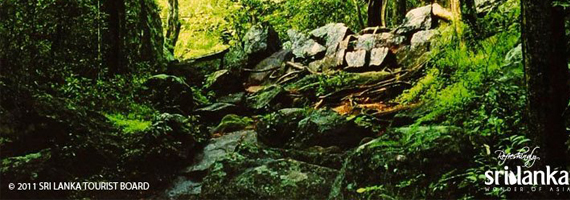Sinharaja

Considered as the finest virgin tropical rain forest areas in Asia, Sinharaja rain forest holds a very important place with high endemism and as a refuge to many endangered species of fauna and flora. The park located in south-west Sri Lanka with more than 60% of the trees being endemic and rare, is also with a very high percentage of endemic wildlife – especially birds. The reserve is also home to over 50% of Sri Lanka’s endemic species of mammals and butterflies, as well as many kinds of insects, reptiles and rare amphibians. Declared as a World heritage site by UNESCO and one of the top 20 bio diversity hotspots in the world offers a glimpse of what the island would have been years ago with a large rain forest cover. Safaris and nature treks can be done at the park now with experienced and knowledgeable naturalist
Yala

The most popular out of the national parks in the country and the second largest, Yala is ranked to have the highest leopard density in the world making it a unique wild life park for animal lovers from all over the world. Home for many species of animals, biggest being the Asian Elephant – a jeep safari at the park can be a pleasant experience to young and old. Water Buffalos, Dear, Wild boar being common sightings – the leopard, sloth bear and crocodiles are recorded seen by many lucky visitors to the park. Covering a land area of 979 Sq Km, the park consists of five blocks of which two are open to the public. Yala hosts a variety of ecosystems ranging from moist monsoon forests to freshwater and marine wetlands. It is one of the 70 Important Bird Areas (IBAs) in Sri Lanka. Yala harbors 215 bird species including six endemic species of Sri Lanka. 44 species of mammals has been recorded from the park.
Wilpattu

The unique feature of this park is the existence of small lakes – Natural, sand-rimmed water basins or depressions that fill with rain water supporting the many habitats of the unique park spread of a land mass of 131693 hectares. 31 species of mammals consisting of the Elephants, Sloth Bear, Leopards and water Buffalos can be seen at the park along with Sambhur, spotted deer, mongoose, mouse and shrew being more common sightings at the park. Many species of birds and reptiles are also found in the park and is located close to Kalpitiya that is fast gaining popularity as a major tourist destination in the country.
Minneriya

Declared a protected area the park is the key catchment area for the historical Minneriya tank built by King Mahasen in 3rd Century AD. The tank provides much needed water to the herds of wild elephants living in the area during dry season. The park provides a guaranteed sighting of wild elephants at any time of the year. Large numbers of Elephants are attracted to grass fields on the edges of the reservoir during the dry season as the Minneriya tank contributes to sustain a large herd of elephants. Individuals of elephants gathered here is numbering around 150-200. Some reports account number of elephants to as high as 700. They migrate here from neighboring Wasgamuwa National Park to share the food and shelter of the park’s forest. Tourists visit Minneriya largely because of elephants, especially in dry season.















